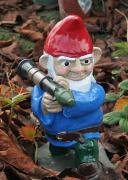
Originally Posted by
LSP972

Basically, a two-edged sword. Its definitely doable, but the doer needs to KNOW what he is about or bad things can happen.
There are two springs which control pull weight; the main spring, and the trigger rebound spring. The former is VERY difficult to "work" without gooning something up, and is best left alone. J frames use a coil mainspring, which is more complex than the leaf spring the larger revolvers employ. A leaf mainspring can actually be worked, albeit carefully, by thinning the sides slightly, or a strategically located bend. Not so the coil type. Anyway, the trigger rebound srping is what most folks attack; either by clipping coils or replacing with a "kit".
I have installed a half-dozen or so of the Apex kits in Centennial J frames. They work fine, and do lessen the pull somewhat; by how much depends on the condition of the hammer and trigger mating surfaces, the frame bosses those parts ride on, and the timing (hand-to-ratchet fit). I have no experience with any other Apex stuff, but they seem to have a handle on it so I would not hesitate to try whatever else they may have for "regular" DA/SA revolvers. A lighter rebound spring couldn't hurt… up to a point.
The problem with a lighter rebound spring is, if you hit the threshold of trigger return energy you have now made your revolver into a sometimes-shooter. A certain amount of energy is needed to get that trigger back forward. Make it too light, and the cylinder can "skip" in rapid fire (AKA "throw-by"). Worst case, the trigger won't go back fully forward without a manual push. Bad juju.
Most everybody seems to think (because they read it over and over again in gun magazines and the internet) that DA revolvers are simple beasts; much simpler than semi-autos. Wrong. Revolver parts move back and forth, up and down, and around and around… all at the same time. Disturb that delicate balance (as most table-top "trigger jobs" do), and you've got trouble. Generally, when you change one thing on a DA revolver, you must adjust another thing to maintain that balance. A good example is the Apex Centennial spring kit; in addition to the lighter trigger rebound spring, you also get a new firing pin and firing pin spring. Both of the latter are necessary to ensure reliable ignition with the lightened DA pull (no SA capability on these guns).
It would be unethical of me to describe methods of lightening trigger pulls using existing parts. What I know, I learned from working on hundreds of the things; and that sort of knowledge is NOT taught in armorer classes. I have a pretty good idea of how far to go, I have the tools and gauges to CHECK how far I've gone, and parts if I go too far and have to start over. Plus, the current MIM parts are NOT the "same" (property-wise; they look the same and work the same, though) as the forged/milled parts I know so well, so I'd be talking out of my ass in any event if the topic is a post-90s gun.
Here's the best advice I can give you. We're talking J frames here; they are for shooting people when the shooter is under high duress. They are not target guns; in fact, if you enjoy shooting a lightweight example for an extended session, then you are more man than me. With that in mind, the smart move is to live with the trigger that the revolver came with. It passed the gauging and reliability tests at the plant (usually); and as we all know, reliability is the number one factor in a defensive firearm; it MUST go bang when you need it to.
As others here have noted, you can smooth up the action a bit by extensive dry firing. My M-360PD, purchased in 2002 and having had in excess of 5K rounds through it, is every bit as smooth and crisp as the 1966-vintage M-37 I worked long and hard over. The only fiddling I did with that piece was to remove the lock mechanism improperly; but that has been covered elsewhere on this forum. My point here is, after the first thousand rounds or so the action improved noticeably. Live firing accelerates the process a bit, because the recoil actually helps "marry" the working parts to each other. Dry firing will do this as well… it just takes longer.
If you simply cannot keep yourself from tinkering, I can recommend the Apex kit for a Centennial J frame. I'm talking about the enclosed hammer model. AFAIK, all J frames made after 1996 or so have frame-mounted inertial firing pins. Whether or not the firing pin and spring included in Apex kit for the 442/642/et. al. will fit an exposed-hammer example, I do not know. A call to Apex would answer that question.
Any other "kit" offerings, etc., I would be leery of. S&W did, for many years, offer a lighter trigger rebound spring for K frames. Made expressly for the single-action-only version of the K-38, a dedicated target piece, it was (and is) a limited item, highly sought after by mechanics doing PPC trigger jobs. I know of no such goodies ever made by them for J frames.
Sorry for the novella, but this is a complex situation that has no easy answers.
.




 Reply With Quote
Reply With Quote

